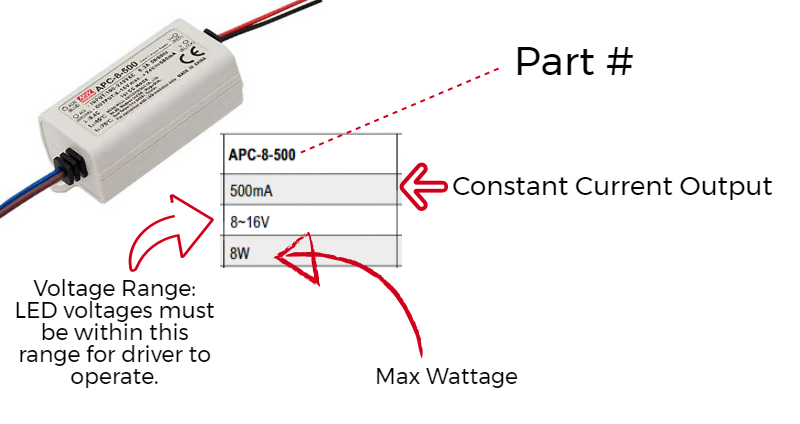Introduction
LEDs for lighting are found anywhere from DIY IoT modules to commercial lighting applications and the cabins of airplanes. To run properly, these critical lighting devices require a precise balance of current and voltage to deliver the right amount of power. Many LEDs used in a home have built-in or external power supplies that convert wall outlet power to the appropriate power for efficient operation of the LEDs. It’s similar, though on a larger and more complex scale, with industrial lighting. Hence, the efficiency, cost, and scalability of the power supply type is important to consider depending upon the application. These factors tie into the types of power supplies used to drive the LEDs.

Constant current LED drivers have a fixed current in amperes or milliamperes and a variable voltage. Constant voltage drivers are similar, but opposite, with fixed voltages and variable currents. Image source: ledsupply.com.
What is the difference between constant voltage and constant current?
A key differentiating factor between LED drivers is if they are constant-current or constant-voltage operation. This matters because many LED technologies are designed to operate only with constant current or constant voltage. The use of a different style of driver can lead to poor operation and even LED failure. LEDs can be damaged by too high a current or too high a voltage, so it’s important to understand the operational parameters of the LEDs themselves before purchasing and installing an LED driver.
How do I know if I need a constant current or constant voltage LED driver?
Constant-voltage LED drivers will typically have a fixed voltage rating of 5 V, 12 V, 24 V, or some other voltage rating with a range of current or maximum current. Constant-current LED drivers will have similar ratings but be given as a fixed amp (A) or milliamp (mA) value with a range of voltages or maximum voltage. The LED device should give an indication of what its power requirements are, along with nominal ranges for voltage and current. If it’s just an LED, then current control is necessary to prevent the LED from going into thermal runaway.
LEDs are diodes that consume power and convert it into light. This process, however, is not perfectly efficient and some internal losses exist, producing heat. As an LED gets hotter, it becomes less efficient and consumes more current. If an infinite current and infinite voltage power supplies were to drive an LED, the LED would continue to draw more current until it failed. Hence, constant-current LED drivers are used to ensure that the current of an LED never leads to thermal runaway.
Which is better?
For industrial lighting, a constant-current driver is common. The drivers are designed to power pre-designed LED systems and may require redesign to account for changes.
Typically, constant-voltage LED drivers are more flexible. This is because more LEDs can be added until the maximum current capability of the constant-voltage LED driver is reached, and then any further LEDs will reduce the available power to every LED, only lowering the brightness.
So how is thermal runaway prevented in constant-voltage LED drivers? Current regulation circuitry is typically included and packaged with the LED, or the constant-voltage LED driver is meant only to power that specific device, such as with an LED light bulb or LED Christmas lights.
Author
Jean-Jacques DeLisle, contributing writer
Related articles:
Advertisement
Learn more about Electronic Products Magazine





